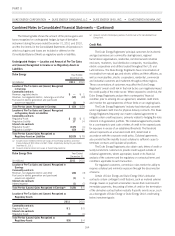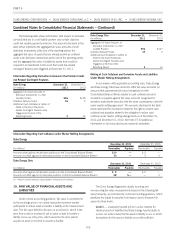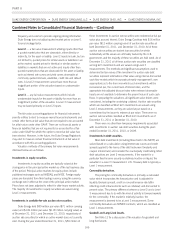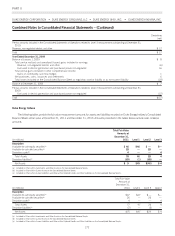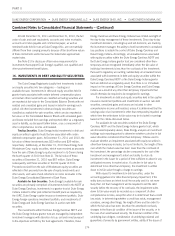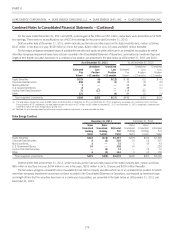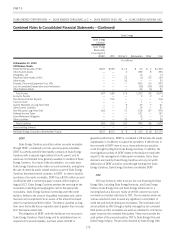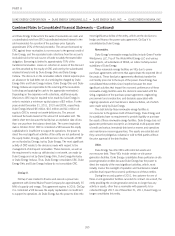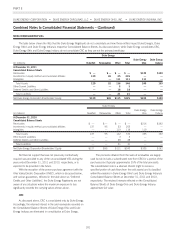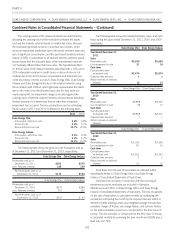Duke Energy 2011 Annual Report Download - page 194
Download and view the complete annual report
Please find page 194 of the 2011 Duke Energy annual report below. You can navigate through the pages in the report by either clicking on the pages listed below, or by using the keyword search tool below to find specific information within the annual report.
PART II
DUKE ENERGY CORPORATION •DUKE ENERGY CAROLINAS, LLC •DUKE ENERGY OHIO, INC. •DUKE ENERGY INDIANA, INC.
Combined Notes to Consolidated Financial Statements – (Continued)
At both December 31, 2011 and December 31, 2010, the fair
value of cash and cash equivalents, accounts and notes receivable,
accounts and notes payable and commercial paper, as well as
restricted funds held in trust at Duke Energy Ohio, are not materially
different from their carrying amounts because of the short-term nature
of these instruments and/or because the stated rates approximate
market rates.
See Note 21 for disclosure of fair value measurements for
investments that support Duke Energy’s qualified, non-qualified and
other post-retirement benefit plans.
16. INVESTMENTS IN DEBT AND EQUITY SECURITIES
The Duke Energy Registrants classify their investments in debt
and equity securities into two categories — trading and
available-for-sale. Investments in debt and equity securities held in
grantor trusts associated with certain deferred compensation plans
and certain other investments are classified as trading securities and
are reported at fair value in the Consolidated Balance Sheets with net
realized and unrealized gains and losses included in earnings each
period. All other investments in debt and equity securities are
classified as available-for-sale securities, which are also reported at
fair value on the Consolidated Balance Sheets with unrealized gains
and losses excluded from earnings and reported either as a regulatory
asset or liability, as discussed further below, or as a component of
other comprehensive income until realized.
Trading Securities. Duke Energy holds investments in debt and
equity securities in grantor trusts that are associated with certain
deferred compensation plans. At December 31, 2011 and 2010, the
fair value of these investments was $32 million and $29 million,
respectively. Additionally, at December 31, 2010 Duke Energy held
Windstream Corp. equity securities, which were received as proceeds
from the sale of Duke Energy’s equity investment in Q-Comm during
the fourth quarter of 2010 (see Note 2). The fair value of these
securities at December 31, 2010 was $87 million. Duke Energy
subsequently sold these securities in the first quarter of 2011.
Proceeds received from the sale of Windstream equity securities are
reflected in Net proceeds from the sale of equity investments and
other assets, and sales of and collections on notes receivable in the
Duke Energy Consolidated Statement of Cash Flows.
Available for Sale Securities. Duke Energy’s available-for-sale
securities are primarily comprised of investments held in the NDTF at
Duke Energy Carolinas, investments in a grantor trust at Duke Energy
Indiana related to other post-retirement benefit plans as required by
the IURC, Duke Energy captive insurance investment portfolio, Duke
Energy foreign operations investment portfolio, and investments of
Duke Energy and Duke Energy Carolinas in auction rate debt
securities.
The investments within the Duke Energy Carolinas NDTF and
the Duke Energy Indiana grantor trust are managed by independent
investment managers with discretion to buy, sell and invest pursuant
to the objectives set forth by the trust agreements. Therefore, Duke
Energy Carolinas and Duke Energy Indiana have limited oversight of
the day-to-day management of these investments. Since day-to-day
investment decisions, including buy and sell decisions, are made by
the investment manager, the ability to hold investments in unrealized
loss positions is outside the control of Duke Energy Carolinas and
Duke Energy Indiana. Accordingly, all unrealized losses associated
with equity securities within the Duke Energy Carolinas NDTF and
the Duke Energy Indiana grantor trust are considered other-than-
temporary and are recognized immediately when the fair value of
individualinvestmentsislessthanthecostbasisoftheinvestment.
Pursuant to regulatory accounting, substantially all unrealized losses
associated with investments in debt and equity securities within the
Duke Energy Carolinas NDTF or the Duke Energy Indiana grantor
trust are deferred as a regulatory asset, thus there is no immediate
impact on the earnings of Duke Energy Carolinas and Duke Energy
Indiana as a result of any other-than-temporary impairments that
would otherwise be required to be recognized in earnings.
For investments in debt and equity securities held in the captive
insurance investment portfolio and investments in auction rate debt
securities, unrealized gains and losses are included in other
comprehensive income until realized, unless it is determined that the
carrying value of an investment is other-than-temporarily impaired, at
which time the write-down to fair value may be included in earnings
based on the criteria discussed below.
For available-for-sale securities outside of the Duke Energy
Carolinas NDTF and the Duke Energy Indiana grantor trust, which
are discussed separately above, Duke Energy analyzes all investment
holdings each reporting period to determine whether a decline in fair
value should be considered other-than-temporary. Criteria used to
evaluate whether an impairment associated with equity securities is
other-than-temporary includes, but is not limited to, the length of time
over which the market value has been lower than the cost basis of
the investment, the percentage decline compared to the cost of the
investment and management’s intent and ability to retain its
investment in the issuer for a period of time sufficient to allow for any
anticipated recovery in market value. If a decline in fair value is
determined to be other-than-temporary, the investment is written
down to its fair value through a charge to earnings.
With respect to investments in debt securities, under the
accounting guidance for other-than-temporary impairment, if the
entity does not have an intent to sell the security and it is not more
likely than not that management will be required to sell the debt
security before the recovery of its cost basis, the impairment write-
down to fair value would be recorded as a component of other
comprehensive income, except for when it is determined that a credit
loss exists. In determining whether a credit loss exists, management
considers, among other things, the length of time and the extent to
which the fair value has been less than the amortized cost basis,
changes in the financial condition of the issuer of the security, or in
the case of an asset backed security, the financial condition of the
underlying loan obligors, consideration of underlying collateral and
guarantees of amounts by government entities, ability of the issuer of
174


